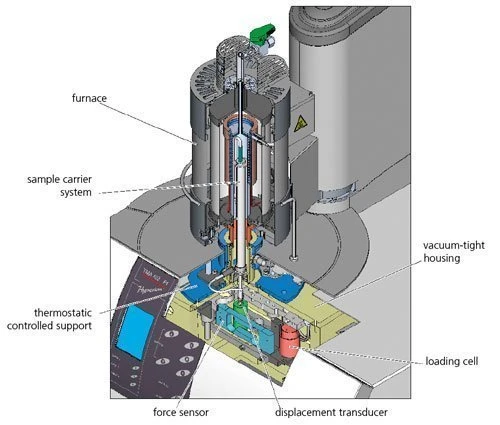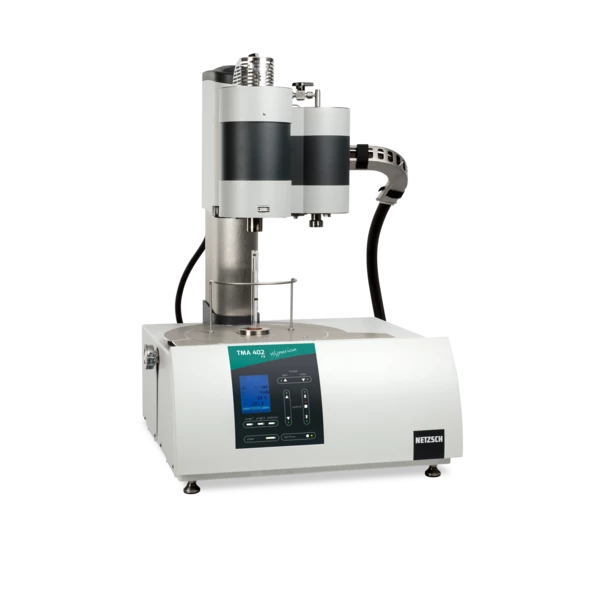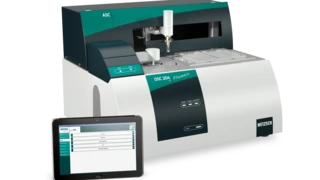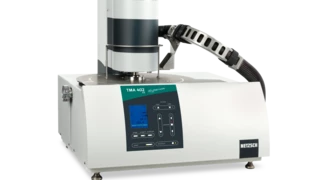Le cœur du TMA 402 Hyperion® est un capteur de déplacement hautement précis (LVDT).
Cette technologie a passé l’épreuve du temps; elle est également utilisée pour les dilatomètres et permet la mesure des plus petites variations dimensionnelles, à l’échelle du nanomètre (résolution digitale de 0.125 nm).
Mesures simultanées de la force et du déplacement
La force appliquée sur l’échantillon est générée électromagnétiquement dans le TMA 402 Hyperion®. Cela garantie un temps de réponse rapide pour les mesures avec une force changeante, par exemple les tests sur le comportement en fluage. Un capteur de force hautement sensible (résolution digitale < 0.01 mN) mesure en permanence la force exercée via le poussoir et la réajuste automatiquement. Cela permet au TMA 402 Hyperion® d’être différent des autres instruments utilisant seulement des valeurs préenregistrées.
Benefits for you
- Modular Concept with interchangeable furnaces (compatible with other NETZSCH instruments) for easy and cost-effective expansion and retrofitting
- Gas flows with up to 4 MFCs, controllable via software with programmable atmosphere change for the analysis of e.g. OxidationOxidation can describe different processes in the context of thermal analysis.oxidation behavior without manual valve operation
- Digitally programmable force or displacement control up to 4 N (only for F1 , 3 N for F3 ) with linear or stepwise force alteration and continuous force modulation for determining visco-elastic properties like RelaxationWhen a constant strain is applied to a rubber compound, the force necessary to maintain that strain is not constant but decreases with time; this behavior is known as stress relaxation. The process responsible for stress relaxation can be physical or chemical, and under normal conditions, both will occur at the same time. relaxation, creep and ContrainteLa Contrainte est définie par un niveau de force appliquée sur un échantillon d’une section bien définie. (Contrainte = force/surface). Les échantillons qui possèdent une section rectangulaire ou circulaire peuvent être comprimés ou étirés. Les matériaux élastiques comme les élastomères peuvent être étirés jusqu’à 5 à 10 fois leur longueur initiale.stress/strain
- Various accessories for an expanded application range, e.g., for measuring powders, liquids, pastes or metals

Determination of viscoelastic properties like Relaxation, Creep and Stress/Strain
The TMA 402 F3 /F1 Hyperion® now offers not only to keep the force constant and to measure the length change, but also to change the displacement and measure the corresponding force. One example where this is used is the stress-RelaxationWhen a constant strain is applied to a rubber compound, the force necessary to maintain that strain is not constant but decreases with time; this behavior is known as stress relaxation. The process responsible for stress relaxation can be physical or chemical, and under normal conditions, both will occur at the same time. relaxation test. This test stretches a sample by a specific amount at a defined temperature. During the test, the deformation is kept constant and the progression of the force is recorded. This force continuously decreases as a result of material RelaxationWhen a constant strain is applied to a rubber compound, the force necessary to maintain that strain is not constant but decreases with time; this behavior is known as stress relaxation. The process responsible for stress relaxation can be physical or chemical, and under normal conditions, both will occur at the same time. relaxation. The stress-RelaxationWhen a constant strain is applied to a rubber compound, the force necessary to maintain that strain is not constant but decreases with time; this behavior is known as stress relaxation. The process responsible for stress relaxation can be physical or chemical, and under normal conditions, both will occur at the same time. relaxation strength is ultimately defined by the residual stress measured after a defined exposure period. The data can be depicted graphically in a stress-time diagram. It is then possible to read off both the stress-RelaxationWhen a constant strain is applied to a rubber compound, the force necessary to maintain that strain is not constant but decreases with time; this behavior is known as stress relaxation. The process responsible for stress relaxation can be physical or chemical, and under normal conditions, both will occur at the same time. relaxation behavior and the values for the RelaxationWhen a constant strain is applied to a rubber compound, the force necessary to maintain that strain is not constant but decreases with time; this behavior is known as stress relaxation. The process responsible for stress relaxation can be physical or chemical, and under normal conditions, both will occur at the same time. relaxation rate and time.
Measurement on sensitive materials but also for higher stresses up to 4N
The electronic control system allows users to set the force value in the mN-range. This enables testing even on sensitive materials such as thin fibers or films. For bigger geometries or higher stresses a force load up to 4 N can be applied using the premium TMA 402 F1 Hyperion® model. The force being exerted upon the sample can be altered via the software in a stepwise or linear fashion. This makes it especially simple to carry out tests such as creep.
Système de mesure thermostaté et étanche au vide
Le système de mesure entier du TMA 402 Hyperion® est stabilisé thermiquement via un refroidissement par eau. Cela garantie que la mesure ne sera pas influencée par la chaleur provenant du four ou par les fluctuations de température de l’environnement extérieur.
Tous les joints sont étanches au vide permettant des mesures sous atmosphère très pure ou sous vide. Des pressions inférieures à 10-4 mBar peuvent être atteintes dans le TMA 402 F1 Hyperion® en utilisant une pompe turbo moléculaire. En combinaison avec les débitmètres massiques intégrés (MFC) pour les gaz de balayage et protecteur (en option dans le TMA 402 F3 Hyperion®), les mesures sous atmosphères inertes ou oxydantes très pures peuvent être contrôlées de façon optimale.
The future is now!
Bring our devices into your laboratory with the click of a button.
Simply scan the QR code and get a 3D model of the instrument directly on your mobile phone or tablet. With the help of the latest AR Technology (Artificial Reality), the 3D model can easily be placed in your laboratory in its original life size. This function is browser-based and requires no app.
Find out and be amazed!

Demander un devis
Spécifications Techniques
Longueur échantillon max.
Gamme de mesure
Résolution dig. (longueur)

Gamme de force
0.001 N to ± 3 N in steps of 0.2 mN
Résolution dig. (force)
< 0.01 mN
Force modulée
jusqu’à 1 Hz (F1 )
Pression de vide finale
< 10-4 mbar
Entrées de gaz
gaz protecteur, 2 gaz de balayage
Gamme de température
-150°C à 1550°C







